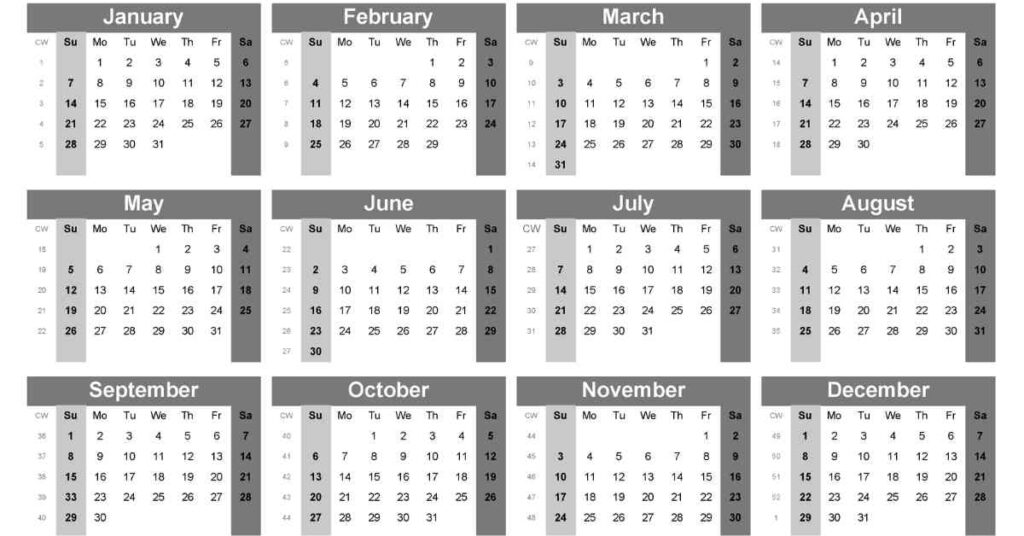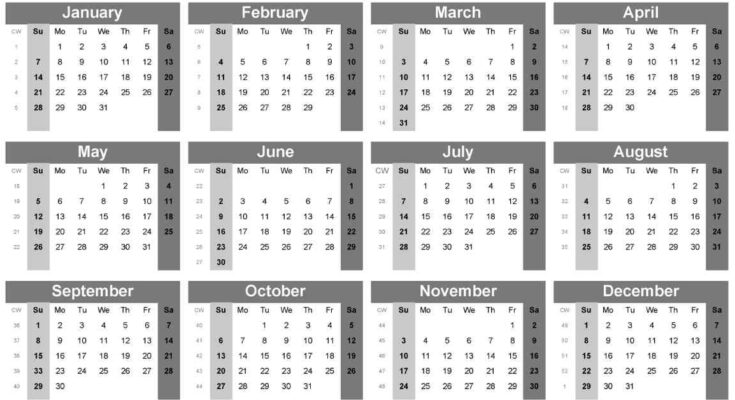As we step into 2024, the need for effective planning and organization becomes paramount. Calendars are an essential tool for managing time, scheduling appointments, and keeping track of important dates. Whether you prefer a traditional paper calendar, a digital calendar, or a hybrid approach, this comprehensive guide will explore the various options available for 2024, their benefits, and how to choose the best calendar to suit your needs.
The Evolution of Calendars
Calendars have been an integral part of human civilization for thousands of years. The earliest calendars were based on the lunar cycles and were used by ancient cultures to track agricultural and religious events. Over time, different societies developed their own calendars, such as the Roman calendar, the Julian calendar, and eventually the Gregorian calendar, which is widely used today.
In the modern era, calendars have evolved to meet the diverse needs of individuals and organizations. From wall calendars and desk planners to digital apps and software, the variety of calendars available today is vast and caters to various preferences and lifestyles.
Types of Calendars for 2024
1. Wall Calendars
Wall calendars are a popular choice for both home and office use. They provide a visual overview of the entire month at a glance, making it easy to plan events and appointments. Wall calendars come in various sizes and designs, from minimalist styles to those featuring beautiful photographs or artwork.
Pros:
- Easy to see and access.
- Available in a wide range of designs.
- Ideal for communal spaces.
Cons:
- Limited portability.
- Requires physical space.
2. Desk Calendars
Desk calendars are compact and designed to sit on a desk or workspace. They are perfect for keeping track of daily tasks and appointments while working. Desk calendars often come with additional features such as to-do lists, notes sections, and inspirational quotes.
Pros:
- Convenient for daily use.
- Enhances productivity at work.
- Often includes additional planning tools.
Cons:
- Limited space for writing.
- May not be as visually appealing as wall calendars.
3. Planner Calendars
Planners, also known as agenda books or organizers, are ideal for those who prefer to have a detailed record of their daily activities. Planners come in various formats, including daily, weekly, and monthly layouts. They often include sections for goal setting, habit tracking, and notes.
Pros:
- Comprehensive planning tool.
- Portable and customizable.
- Encourages goal setting and habit tracking.
Cons:
- Requires regular updating.
- Can be bulky to carry around.
4. Digital Calendars
Digital calendars have gained immense popularity due to their convenience and integration with other digital tools. Apps like Google Calendar, Apple Calendar, and Microsoft Outlook allow users to schedule events, set reminders, and sync across multiple devices. Digital calendars are accessible from smartphones, tablets, and computers.
Pros:
- Highly portable and accessible.
- Features like reminders and notifications.
- Easy to share and collaborate with others.
Cons:
- Requires a device and internet access.
- Can be distracting with other apps.
5. Hybrid Calendars
Hybrid calendars combine the features of traditional paper calendars with digital tools. These can include smart planners that sync with digital calendars, or apps that offer printable planner templates. Hybrid calendars cater to those who appreciate the tactile experience of writing while enjoying the benefits of digital integration.
Pros:
- Combines the best of both worlds.
- Flexible and customizable.
- Appeals to both digital and paper calendar users.
Cons:
- May require additional setup.
- Can be more expensive than single-type calendars.
Choosing the Right Calendar for 2024
Selecting the right calendar depends on your personal preferences, lifestyle, and organizational needs. Here are some factors to consider:
1. Purpose
Determine the primary purpose of your calendar. Are you using it for personal planning, work scheduling, or both? Do you need to track daily tasks, long-term goals, or important dates? Understanding your purpose will help you choose the most suitable type of calendar.
2. Portability
Consider how often you need to carry your calendar with you. If you need a calendar that you can easily take on the go, a planner or digital calendar might be the best choice. If you prefer a stationary option, a wall or desk calendar could be more appropriate.
3. Customization
Think about how much customization you need. Digital calendars offer a high level of customization with color-coding, recurring events, and integration with other apps. Planners and hybrid calendars also allow for personalization, while wall and desk calendars may offer limited customization options.
4. Visual Appeal
Visual appeal can play a significant role in staying organized. Choose a calendar design that you find aesthetically pleasing and motivating. Whether it’s a sleek digital interface or a beautifully designed wall calendar, the visual aspect can enhance your planning experience.
5. Additional Features
Look for additional features that may enhance your productivity. Digital calendars often come with reminder notifications, integration with email, and sharing capabilities. Planners may include sections for goal setting, habit tracking, and notes. Consider what extra features are important to you.
Popular Calendar Brands and Apps for 2024
1. Google Calendar
Google Calendar is one of the most widely used digital calendars. It offers seamless integration with other Google services, allows for easy sharing and collaboration, and provides customizable reminders. The app is available on both Android and iOS devices and can be accessed from any web browser.
Features:
- Syncs with Gmail and Google Tasks.
- Customizable event colors and reminders.
- Supports multiple calendars.
2. Apple Calendar
Apple Calendar, also known as iCal, is a popular choice for Apple device users. It syncs across all Apple devices, including iPhone, iPad, and Mac. The app offers a clean and intuitive interface, with features such as event alerts, time zone support, and integration with other Apple apps.
Features:
- Syncs with iCloud for seamless access.
- Supports natural language input for events.
- Integration with Siri for voice commands.
3. Microsoft Outlook Calendar
Microsoft Outlook Calendar is part of the Microsoft Office suite and integrates well with other Office apps such as Outlook Mail, OneNote, and Teams. It is available on both Windows and macOS, as well as Android and iOS devices. Outlook Calendar is ideal for business users who need a robust scheduling tool.
Features:
- Integration with Microsoft Office apps.
- Advanced scheduling and meeting management.
- Supports multiple time zones.
4. Moleskine Planner
Moleskine is known for its high-quality paper products, and their planners are no exception. Moleskine planners come in various formats, including daily, weekly, and monthly layouts. They offer a classic and elegant design, perfect for those who appreciate the tactile experience of writing.
Features:
- High-quality paper and durable cover.
- Includes planning and note-taking sections.
- Available in various sizes and formats.
5. Passion Planner
Passion Planner is a popular choice for those who want to combine goal setting with daily planning. The planner includes sections for monthly reflections, goal setting, and weekly layouts with plenty of space for notes. Passion Planner also supports a community of users with resources and inspiration.
Features:
- Goal setting and reflection sections.
- Weekly and monthly layouts.
- Available in various sizes and colors.
Tips for Maximizing Your Calendar’s Potential in 2024
1. Set Clear Goals
Begin the year by setting clear and achievable goals. Use your calendar to break down these goals into smaller, manageable tasks. Regularly review and adjust your goals as needed to stay on track.
2. Prioritize Tasks
Use your calendar to prioritize tasks and focus on what is most important. Identify high-priority tasks and schedule them for times when you are most productive. Use color-coding or labels to differentiate between different types of tasks.
3. Schedule Regular Breaks
Avoid burnout by scheduling regular breaks throughout your day. Use your calendar to block out time for short breaks, lunch, and personal time. Taking breaks can help improve focus and productivity.
4. Plan Ahead
Take some time at the beginning of each week or month to plan ahead. Review your calendar and schedule upcoming tasks, appointments, and events. Planning ahead can help you stay organized and reduce last-minute stress.
5. Utilize Reminders
Set reminders for important tasks and deadlines. Digital calendars offer customizable reminders that can be set to notify you at specific times. Use these reminders to stay on top of your schedule and avoid missing important events.
6. Reflect and Adjust
At the end of each month, take some time to reflect on your accomplishments and areas for improvement. Use this reflection to adjust your planning strategies and set new goals for the upcoming month.

Conclusion
Calendars are invaluable tools for staying organized and productive in 2024. Whether you prefer a traditional paper calendar, a digital app, or a hybrid approach, there are plenty of options available to suit your needs. By choosing the right calendar and implementing effective planning strategies, you can make the most of your time and achieve your goals.
As you navigate through 2024, remember to set clear goals, prioritize tasks, schedule regular breaks, plan ahead, utilize reminders, and reflect on your progress. With these tips and the right calendar, you’ll be well-equipped to make this year your most organized and productive yet.




